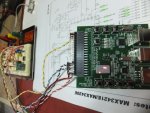Maxim_IC offers EVKit based on the MAX3421 - USB host IC, that can be directly connected to Arduino.
If AXE401 development board is compatible with Arduino (I/Os), is it possible to program PICAXE 28X2 on the AXE401 board so when connected with MAX3421-EVkit would work as an USB host?
If AXE401 development board is compatible with Arduino (I/Os), is it possible to program PICAXE 28X2 on the AXE401 board so when connected with MAX3421-EVkit would work as an USB host?
Last edited:


